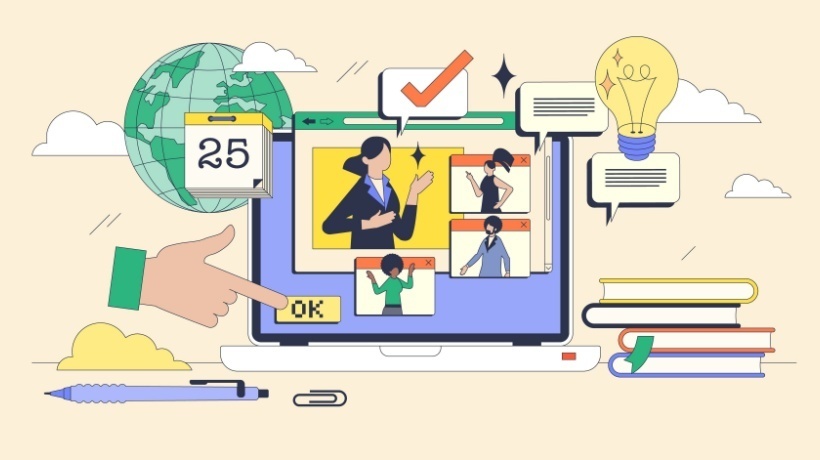What is a digital classroom?
Perhaps it would be wise to brainstorm not only what a digital classroom really is but what we want it to be.
“May you live in interesting times.”
“As educationalists, we do live in very interesting times and that can be either a curse or a blessing depending on how you feel about the role of technology in education and the degree to which you are willing to engage with it. Personally, I feel that it’s a blessing and that we are very lucky to be living in times that offer us the opportunity to radically change and improve the way we educate our students.”
Nik Peachey
Here’s a brief visualization of what a digital classroom could be based on my own readings, searches, and thoughts.

Assuming that this mindmaps represents an ideal digital classroom set-up with technology, psychology and social learning dynamics in place, let’s proceed with the list of top ten things teachers want from digital classrooms. My list is based on the results of a questionnaire created by Educational technology expert, Nik Peachey. Using a collaborative brain-storming tool called tricider, Nik asks us to contribute ideas on what we’d like to see in an ebook about exploiting online video in the digital classroom? The ideas are then voted upon and we can clearly see which ideas are the most popular. Although his first book is about exploiting video, he’s planning a whole series of books about the full range of things we need to know regarding the digital classroom.
“The ideas here are worthy of a series, not just a single book ;-)”
Ali bournoussa
- Teachers want to know how to manage diverse types of digital environment. They are particularly interested in online and blended learning paradigms such as flipped learning.
- They feel that video tutorials are a must for demonstrating new technology.
- They would like reviews of different types of apps for creating videos, including suggestions about how to use the app for learning purposes.
- They want to let student create their own video content for authentic purposes and to feel pride in their work.
- They want tips on how to exploit the visual aspects of video.
- Ideas and advice for using video in digital narrative.
- Advice on how to choose an appropriate clip.
- Suggestions for action plans and tasks teachers can do to start incorporation video technology into their teaching.
- Ideas about how to exploit the visual aspect of the video rather than just for listening comp.
- A tool box of useful applications for doing things like video editing, clipping, download, etc.
If you wish to add your ideas about what you’d like to see in a book about video in your digital classroom you can add your voice hereIf you want to contribute towards this project you can learn more about it here. The funding campaign is a win-win model for crowd-sourcing and grass-roots collaboration. Nik has collected eighty percent of the 5,000GBP funding that he needs to write the book that will map out our changing English language teaching landscapes and give us the power to create our own personalized Edtech ticket to everywhere.Don’t forget to read my recent interview with Nik Peachey on WiziQ. Here’s a recording and video pdf. of a recent webinar and here’s the powerpoint.Personally speaking I have decided to add an extra contribution of my own. I’ve decided to run ten free online workshops to guide you through implementing new skills and ideas from the book into your classes" This would include asynchronous mentoring, brainstorming and community based support.Although everything we need to learn will be in the book and video demonstrations, I thought it would be a great social learning experiment to share this journey into the digital classroom together. I have moderated quite a few open online courses and MOOCs so I can guarantee a supportive and inspiring experience.One example of something right down my street would be this amazing tool shared by Nik Peachey on his blog called ‘storytime’. It’s a tool that combines video conferencing with reading stories out loud and it’s perfect for tutoring young learners online.Something else for us to consider is that with new knowledge on video tools for mobile technology we have to power to interact with the best educational videos online and turn them into our own creative toys. For example, Jason R. Levine’s Collo tunes. They can be turned into speaking practice videos through the clever us of apps. That allows us to interact directly with the music content and then build upon it in communicative ways.One example is you could use eye report and let students add commentary to the collo videos. That could actually turn into collaborate rhyming and rapping as each students to add their own words to the songs. Or it could become a grammar chain story as each students would add a grammatically phrased sentence that matches the teaching point from the Fluency MC rap. Jason R. Levine has offered to hold a web 3.0 webinar on how to implement ideas from Nik Peachey’s video book and use them for enhancing interactivity with his Collo Tunes.Exciting times ahead with Web 3.0 and digital classrooms – let’s all share the experience









